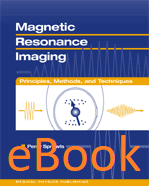
Magnetic Resonance Imaging: Principles, Methods, and Techniques, eBook
Author: Perry SprawlsISBN: 9781951134044
Published: 2000 | 200 pp | eBook
Price: $ 45.00
Interactions, the newsletter of the COMP | January 2001
"Perry Sprawls is probably one of the most qualified in North America to write a straightforward, non-mathematical textbook on MRI. Perry has been teaching MRI to physicians, technologists and phyisicists since the earliest days of MRI and the book reflects the care and thought that he has put into educating his audience.
“This new textbook is aimed first and foremost at the physician and technologist, who neither possesses nor has the wish to grasp the mathematical foundation of MRI imaging. This is not to say however that the book is inappropriate for the bookshelf of a Medical Physicist. Not only does it manage to convey the essential physical principles of MRI without the use of a single equation (let alone integral!), he does so with astonishing clarity.
“One of the novel aspects of the book is the use of a ‘Mind Map’ - a one-page text and graphics summary of the preceding chapter. The mind-map links the topics of the foregoing chapter together succinctly, and provides the reader with the ‘take-home’ message for the chapter.
“The book is organized into 15 chapters, beginning with a description of MRI image characteristics, and the hardware involved in acquiring MR data, followed by 2 chapters covering the basic physics of NMR and relaxation mechanism. This is followed by several chapters conveying the imaging process itself. Here, as in the rest of the book, the reader is introduced to major section through an overview of the subject, which is then further developed in subsequent sections or chapters. This approach, which presumably reflects Dr. Sprawls’ teaching style, is extremely helpful in getting the reader excited about what is to come, and establishing a clear context for the material that is to follow.
“The text progresses logically through a treatment of spin-echo and gradient echo imaging methods, and leads into a discussion of selective signal suppression, covering such topics as fat and fluid suppression, magnetization transfer and regional saturation.
“These first eight chapters manage to convey the essence of many complex principles, without introducing the basics of Fourier imaging (apart from acknowledging that the acquired data are stored in an array called ‘k-space’). Chapter 9 however introduces the explicit relationship between gradients and the imaging process through the introduction of the concepts of ‘frequency encoding’ and ‘phase encoding’ imposed by gradients. Again, the liberal use of clear diagrams conveys the essentials to the reader in an effective fashion. My only minor quibble about this book is there is no footnote explaining that, at the level of ‘k-space’, there is no fundamental difference between ‘frequency’ and ‘phase’ encoding. While I suspect this was deliberately omitted for simplicity, a statement to this effect could be helpful to a reader when subsequently moves on to understand more complex acquisition protocols (e.g. spiral, echo- planar),
“Chapters 10 and 11 deal with image detail/noise, and acquisition optimization respectively, while the following two chapters treat vascular and functional imaging techniques respectively. Chapter 14 (Image Artifacts) discusses many of the more commonly observed MR artifact phenomena and outlines the means of minimizing their effect. The text concludes with a discussion of safety aspects relevant to MR imaging.
“This book is a ‘must have’ text for the medical physicist, who is certain to make extensive use of its clear approach when teaching, but will also find it extremely valuable as a means of brushing up on many of the concepts behind MR imaging.
“Dr. Sprawls is to be congratulated on a fine piece of work. Both thumbs up!”
Terry Peters
John P. Robarts Research Institute


